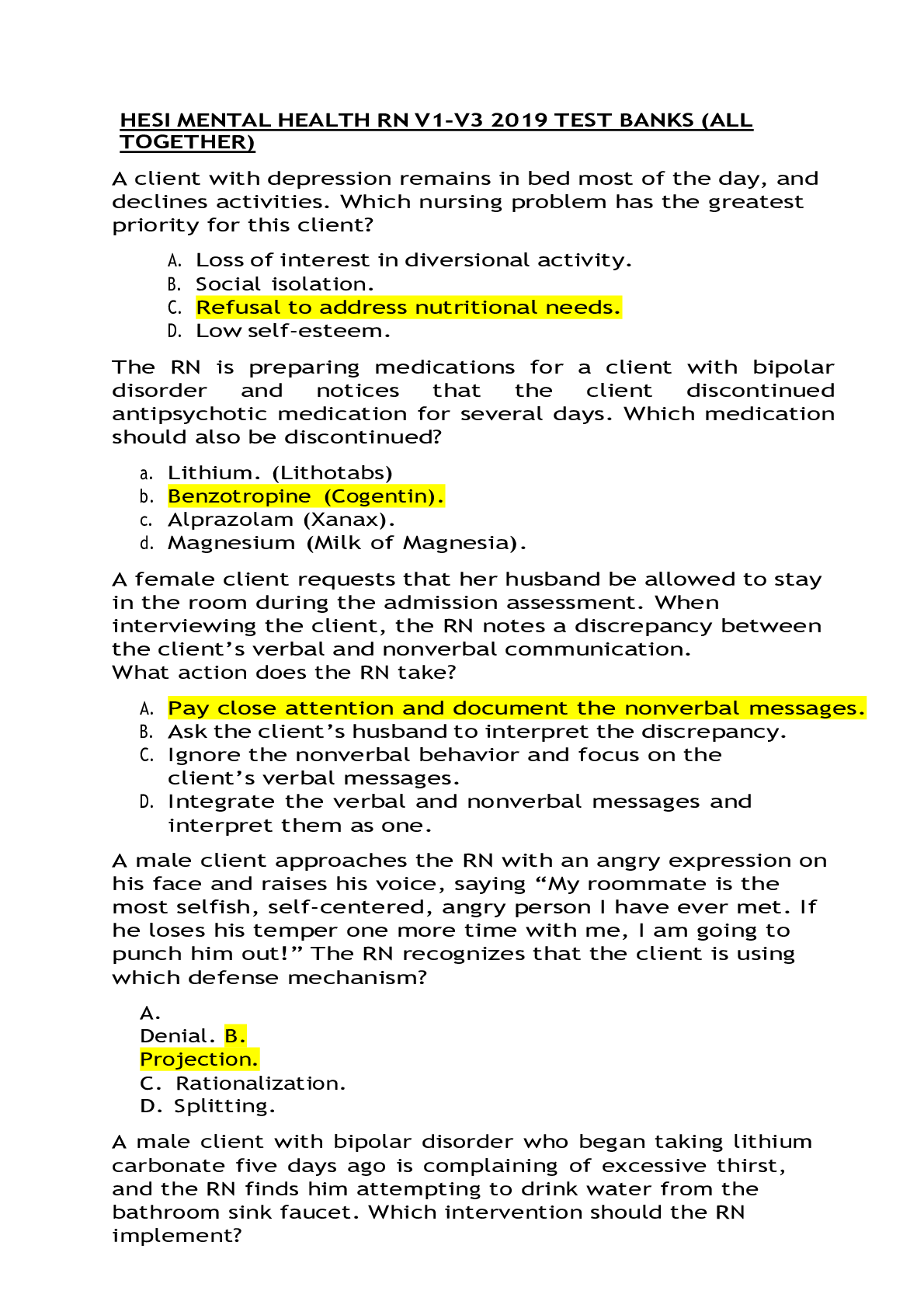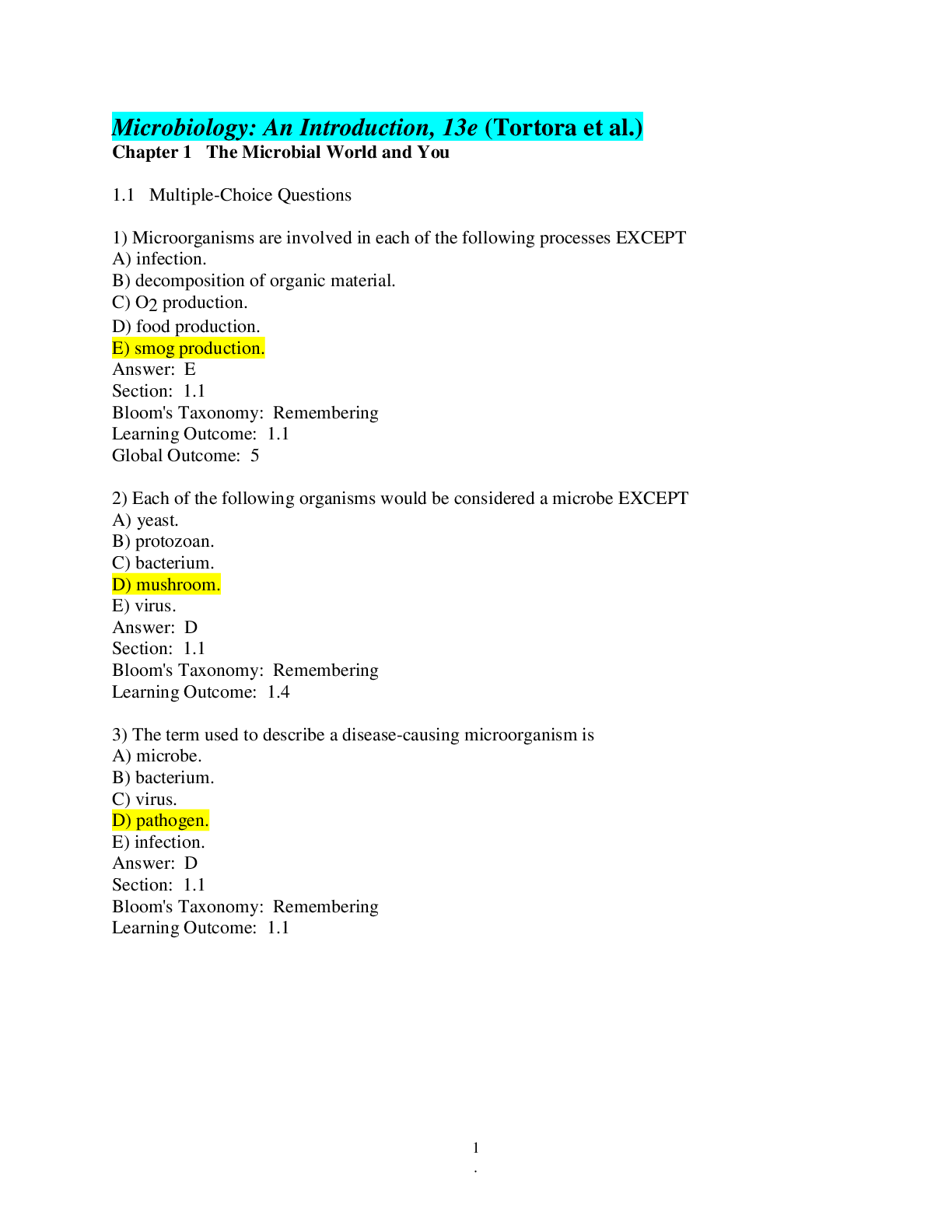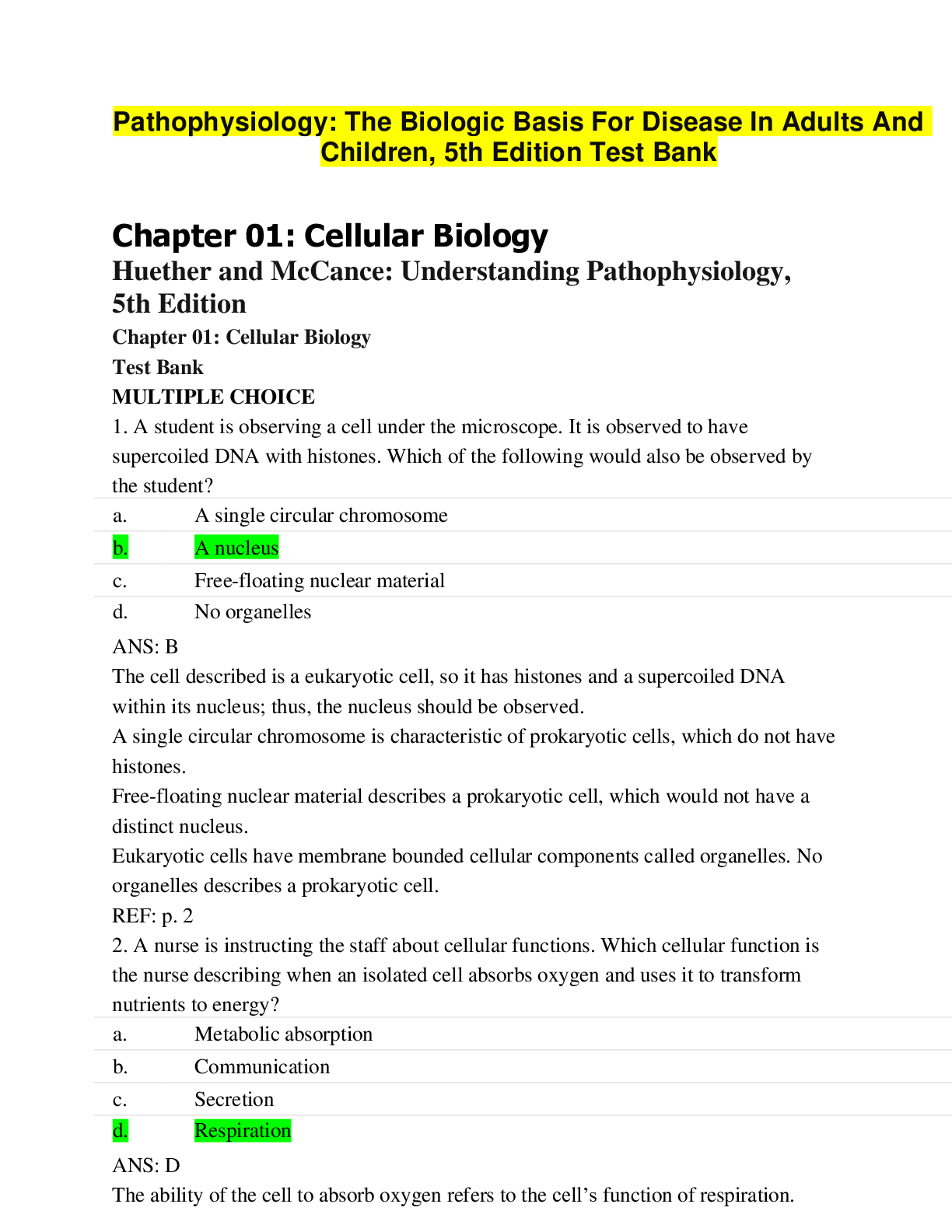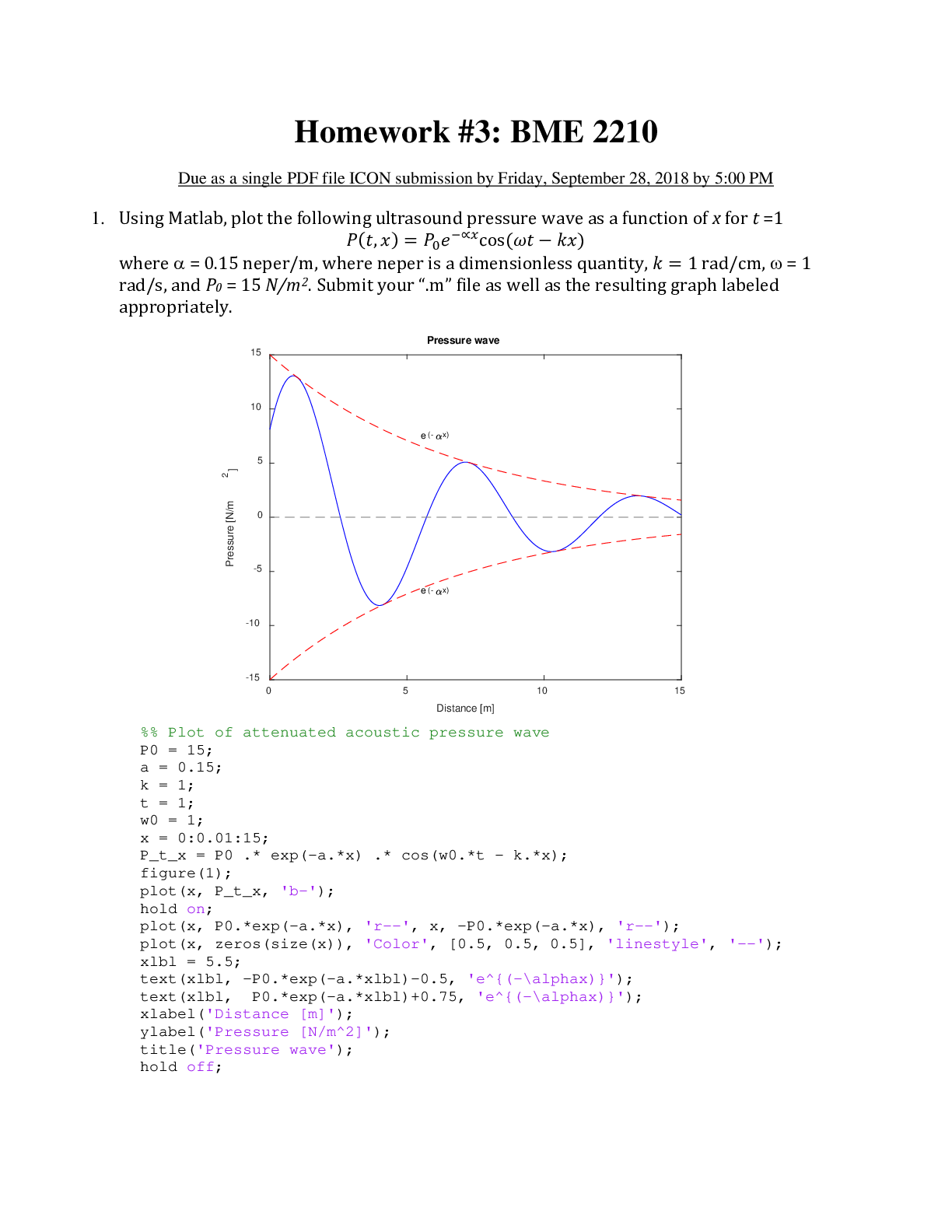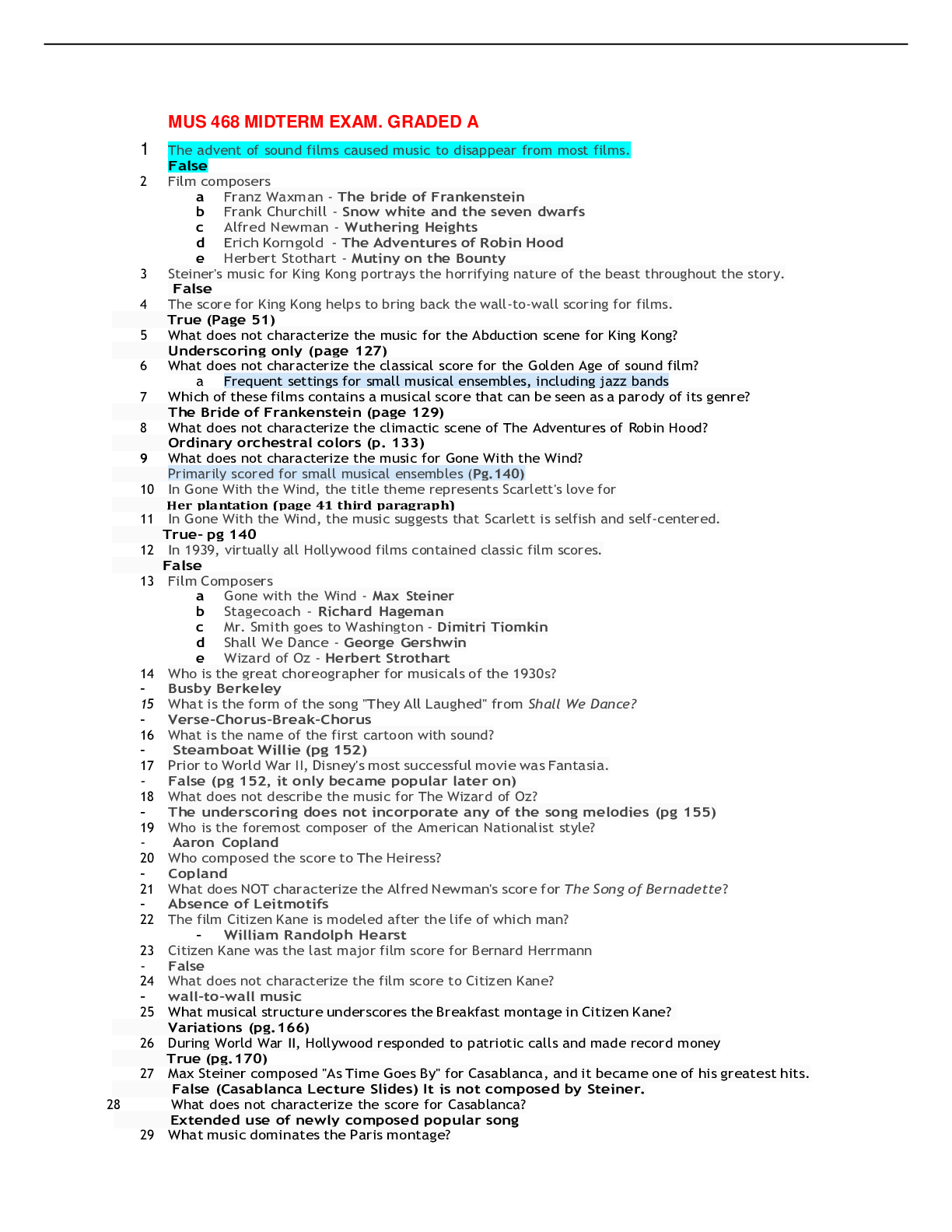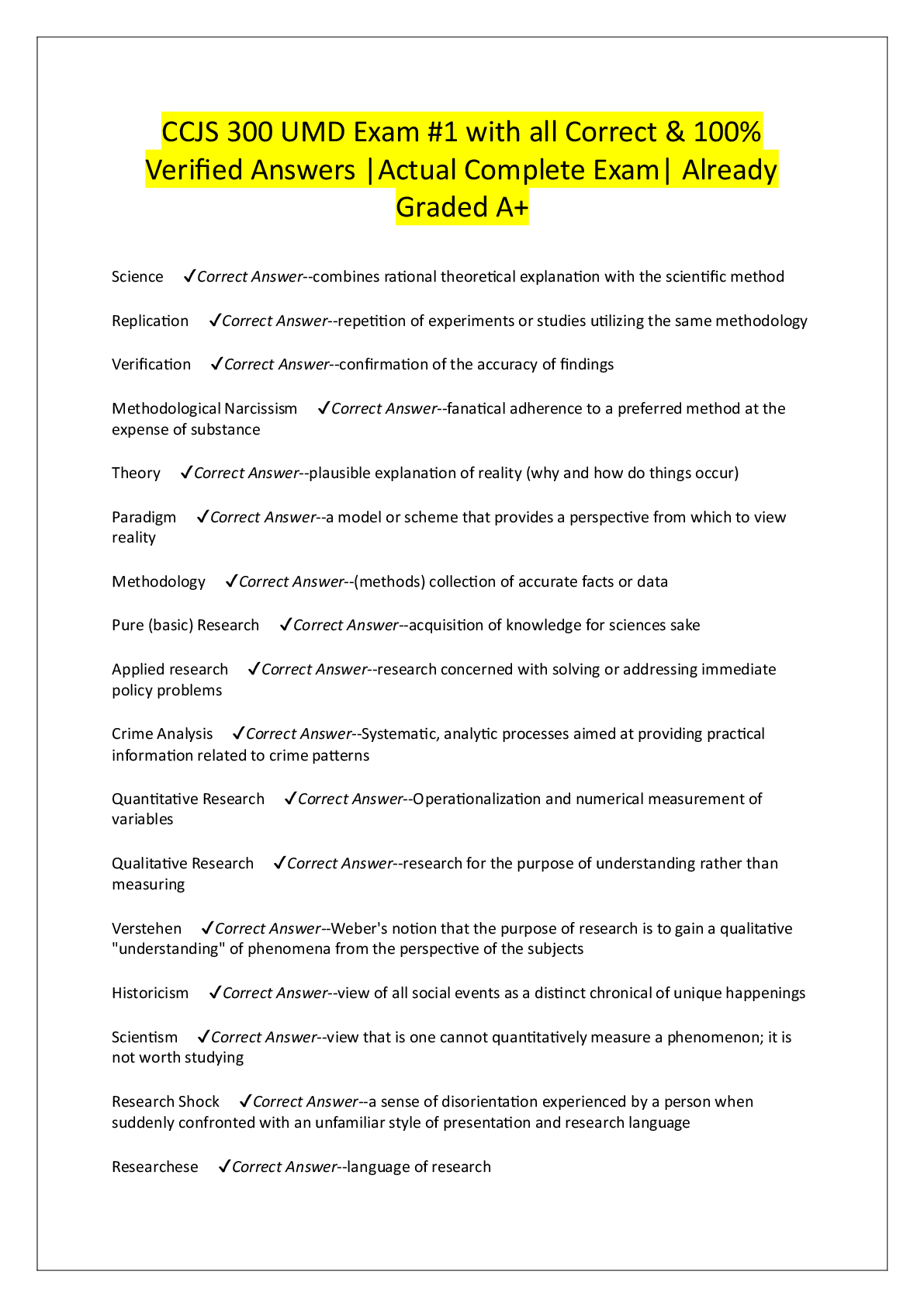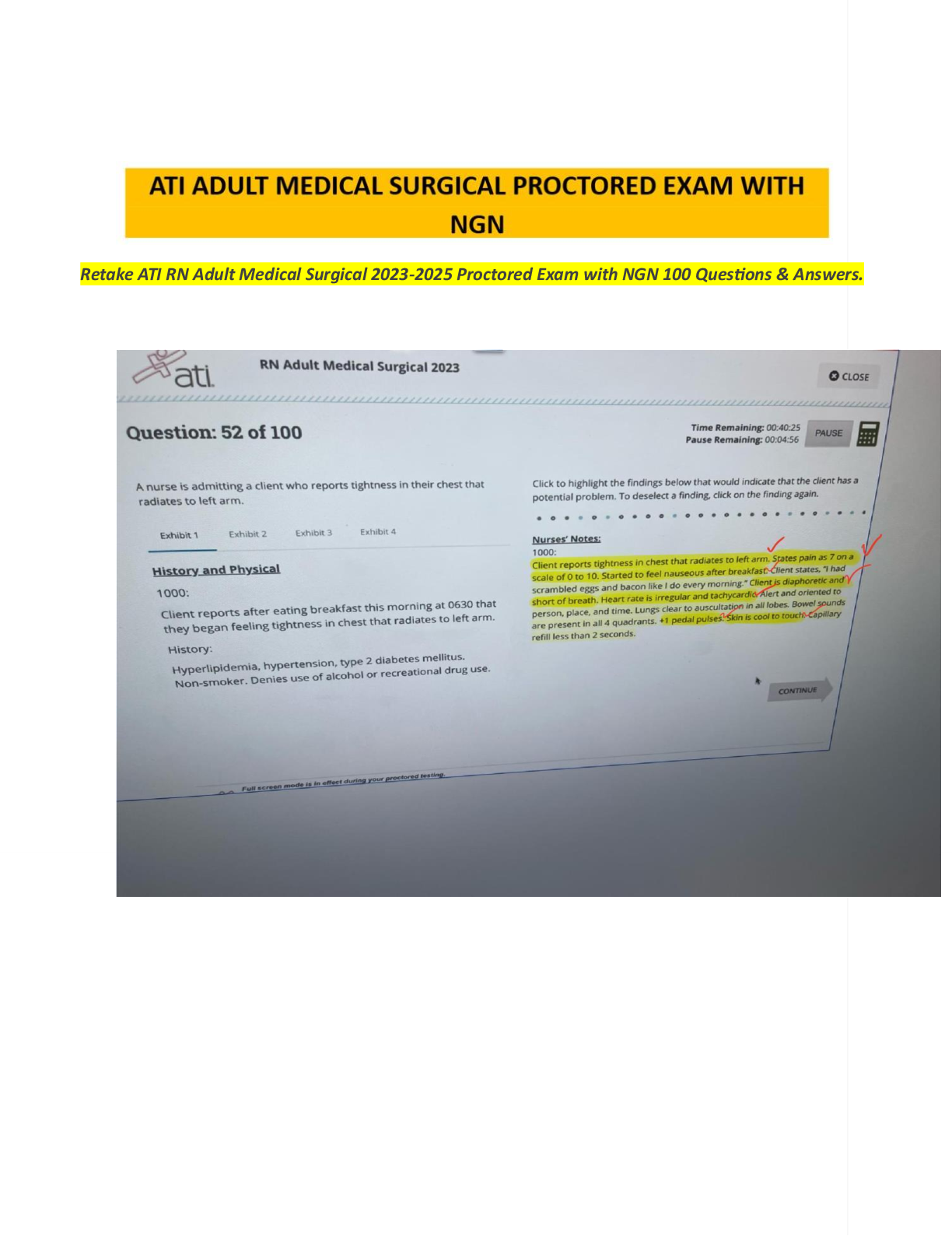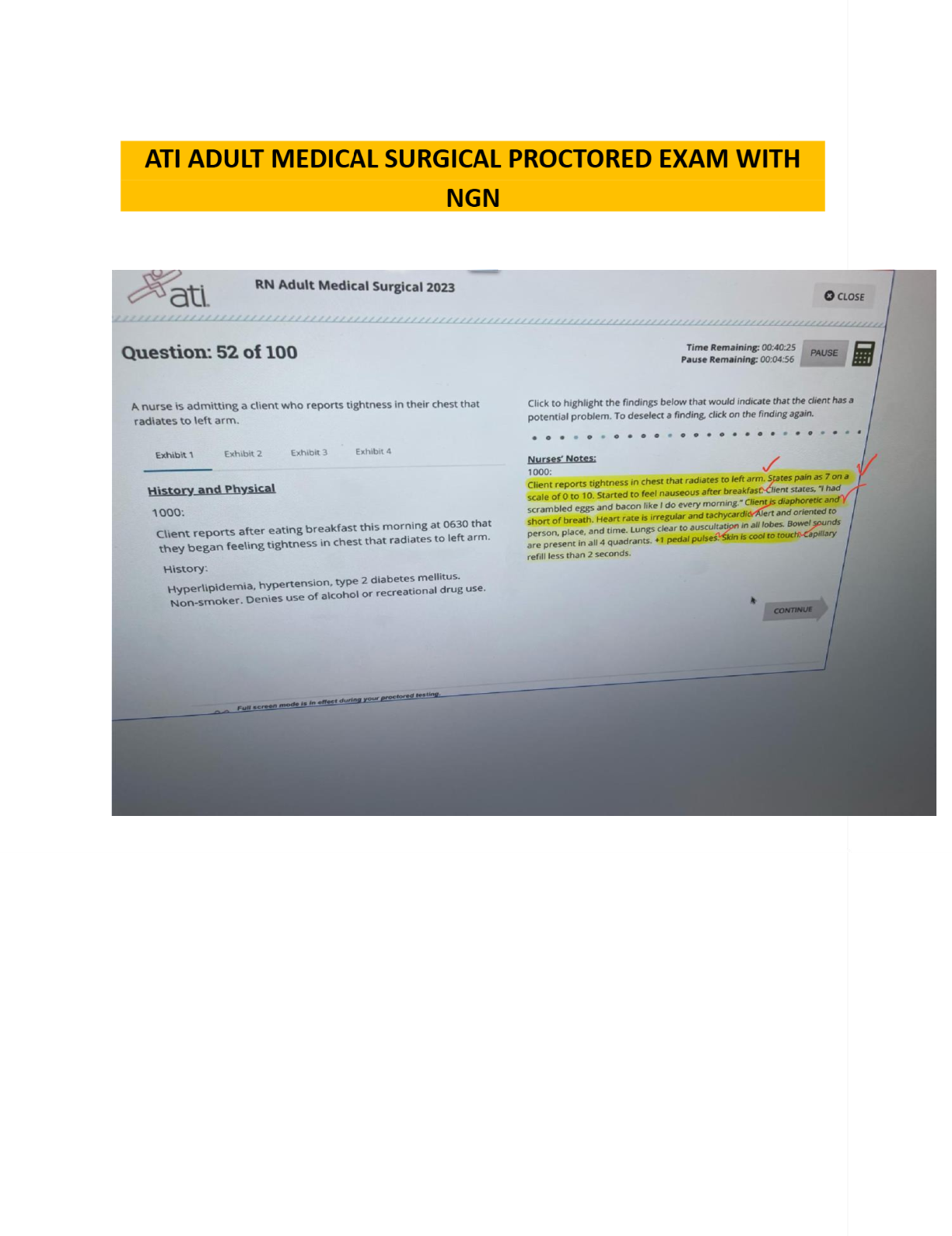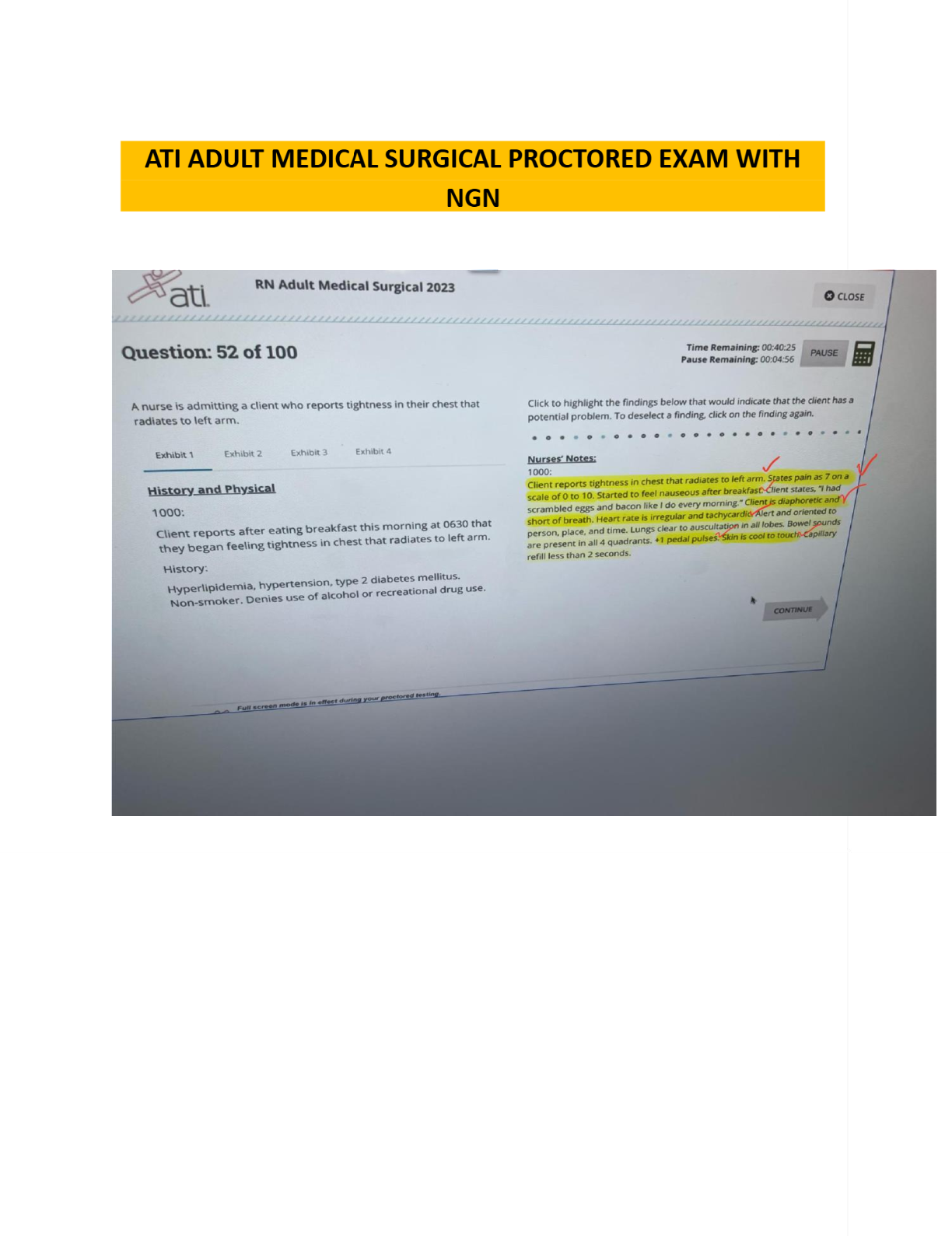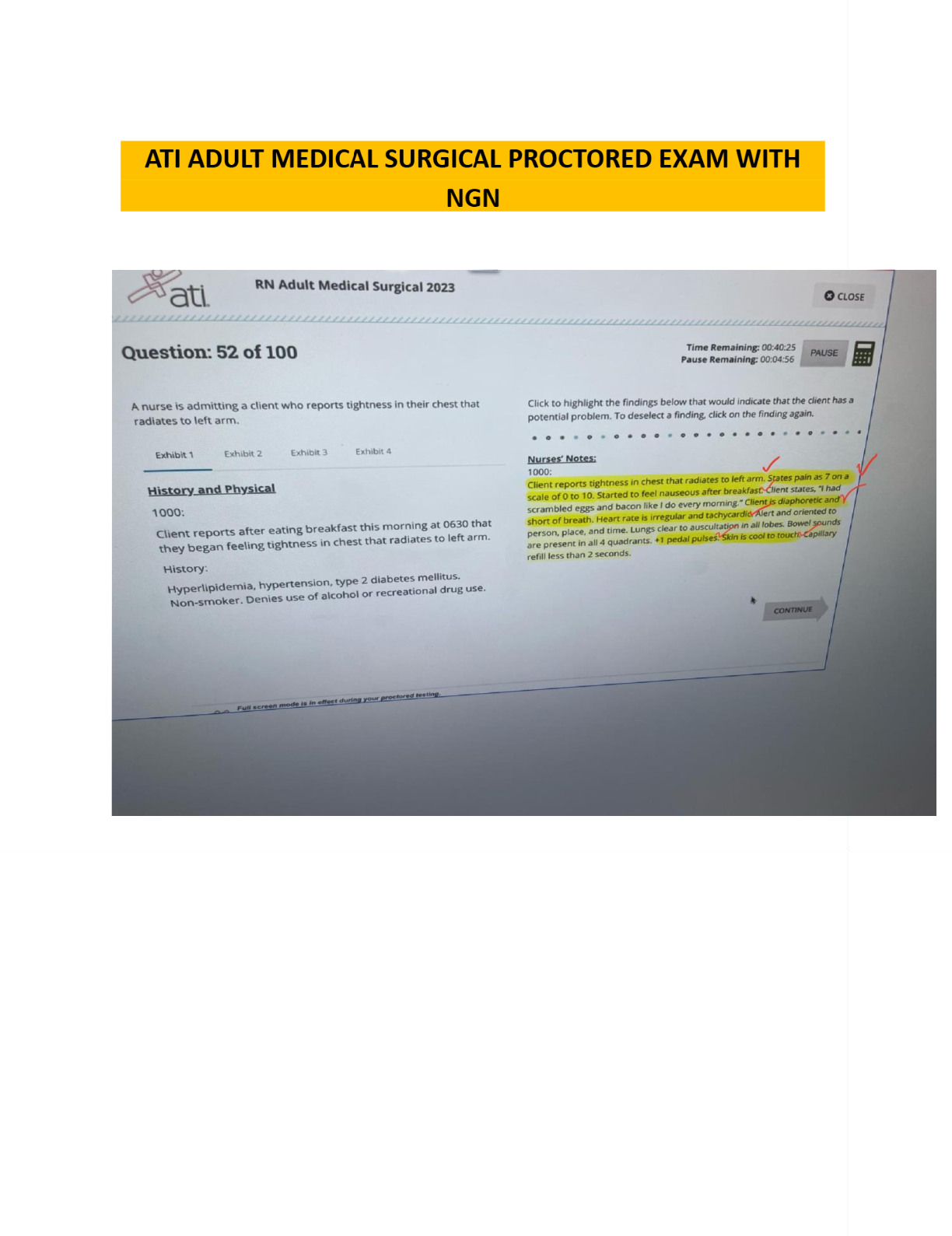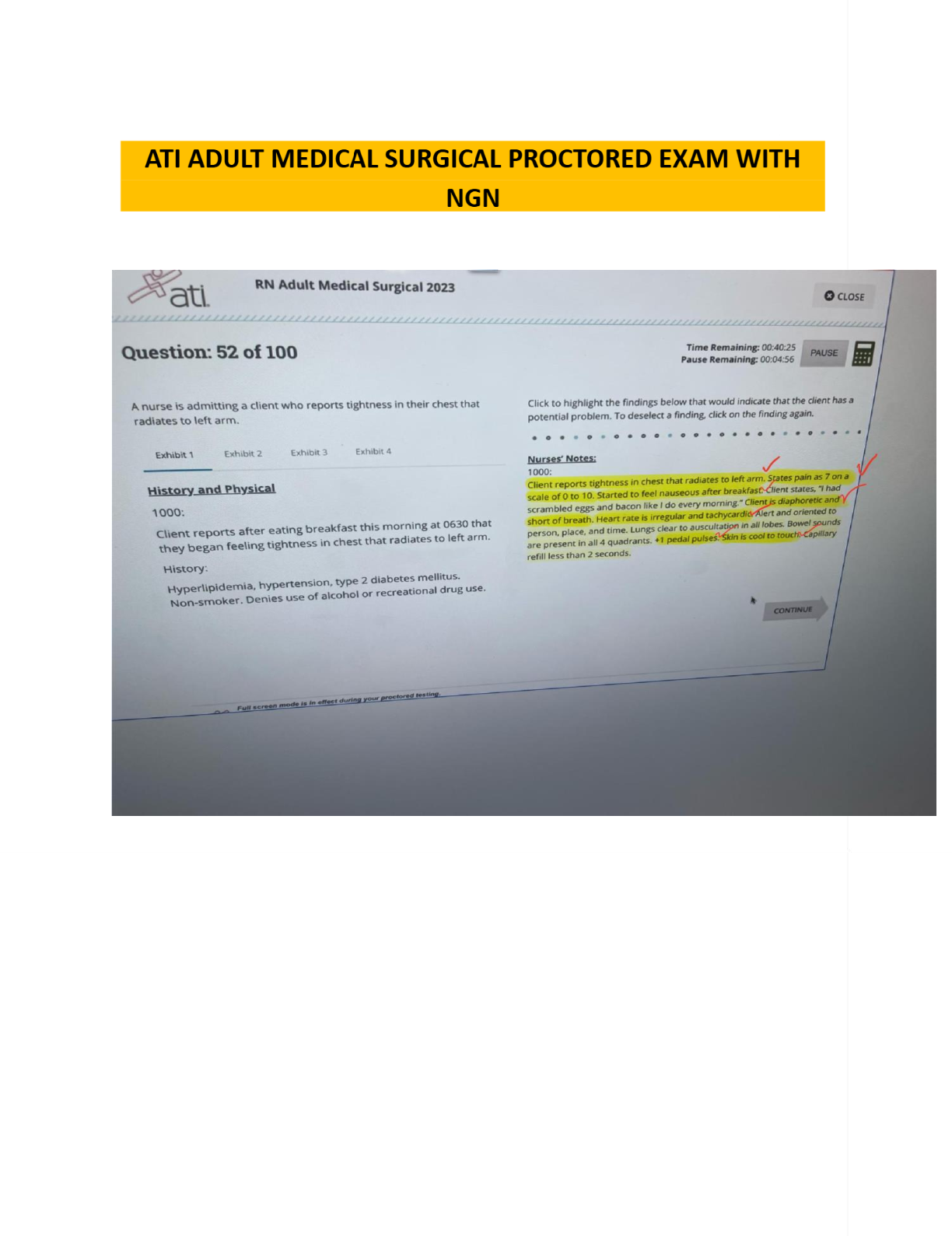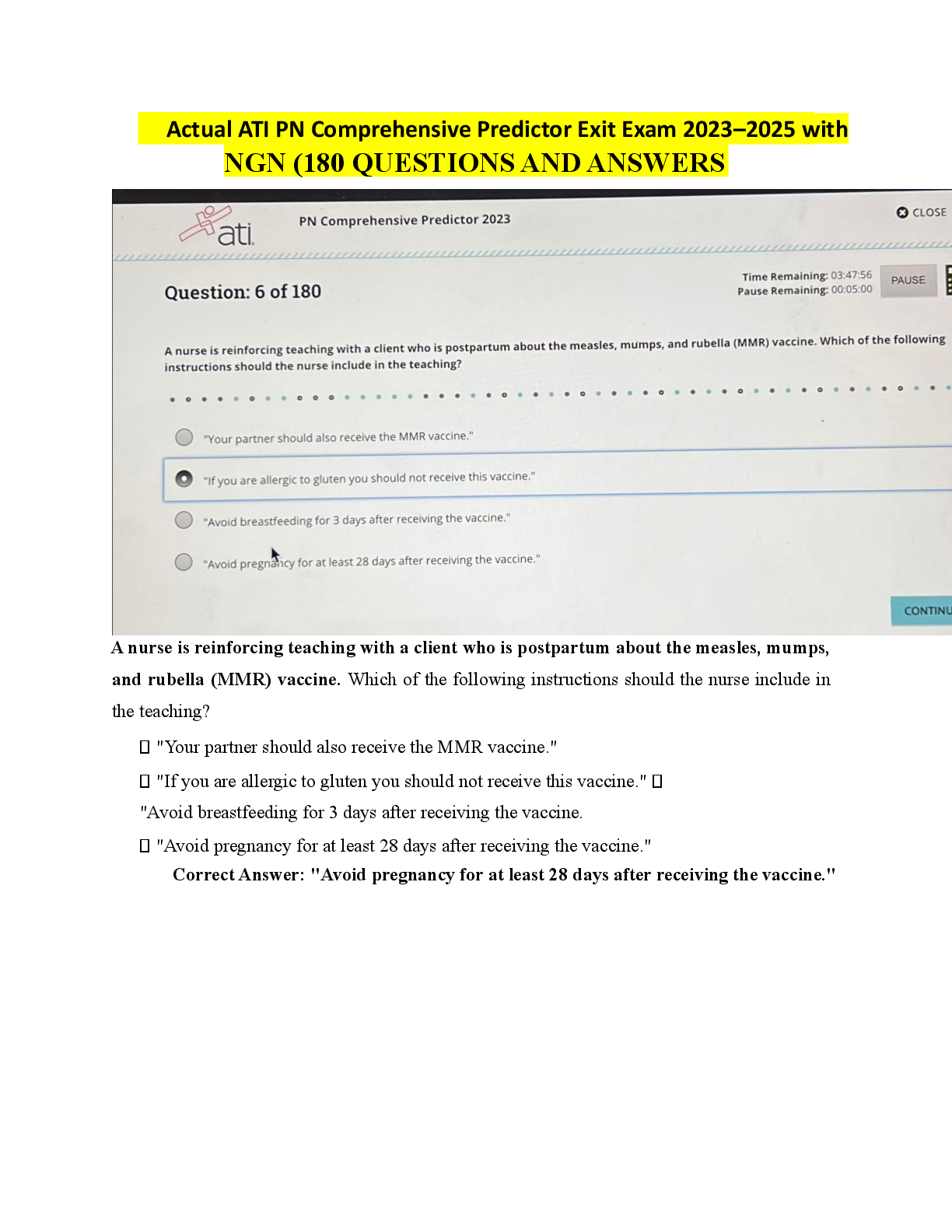PATHO MIDTERM EXAM. Questions & Answers. GRADE A
Document Content and Description Below
PATHO MIDTERM EXAM Question 1 After the baroreceptor reflex is stimulated, the resulting impulse is transmitted from the carotid artery by which sequence of events? From the vagus nerve to ... the medulla to increase parasympathetic activity and to decrease sympathetic activity From the glossopharyngeal cranial nerve through the vagus nerve to the medulla to increase sympathetic activity and to decrease parasympathetic activity From the glossopharyngeal cranial nerve through the vagus nerve to the medulla to increase parasympathetic activity and to decrease sympathetic activity From the glossopharyngeal cranial nerve through the vagus nerve to the hypothalamus to increase parasympathetic activity and to decrease sympathetic activity Neural impulses are transmitted over the glossopharyngeal nerve (ninth cranial nerve) from the carotid artery and through the vagus nerve from the aorta to the cardiovascular control centers in the medulla. These centers initiate an increase in parasympathetic activity and a decrease in sympathetic activity, causing blood vessels to dilate and the heart rate to decrease. This selection is the only option that accurately describes the sequence of events asked for in the question. Question 2. Question Some older adults have impaired inflammation and wound healing because of which problem? The circulatory system cannot adequately perfuse tissues. Complement and chemotaxis are deficient. Underlying chronic illnesses exist. The number of mast cells is insufficient. In some cases, impaired healing is not directly associated with aging, in general, but can instead be linked to a chronic illness such as cardiovascular disease or diabetes mellitus. The other problems are not related to the aging process. Question 3. Question Phagocytosis involves neutrophils actively attacking, engulfing, and destroying which microorganisms? Bacteria Fungi Viruses Yeasts Invasion is the direct confrontation with an individual’s primary defense mechanisms against only bacteria, which include the complement system, antibodies, and phagocytes, such as neutrophils and macrophages. Question 4. Question Which T cells control or limit the immune response to protect the host’s own tissues against an autoimmune response? Cytotoxic T (Tc) cells Helper T 1 (Th1) cells Helper T 2 (Th2) cells Regulatory T (Treg) cells The Treg cell is the only option whose role is to control or limit the immune response to protect the host’s own tissues against autoimmune reactions. Question 5. Question Diagnostic blood work on individuals who perceive themselves to be in a chronic stress state will likely demonstrate Decreased helper T (Th) lymphocytes Increased erythrocytes Decreased cytotoxic T (Tc) cells Increased platelets Illustrating the influence of chronic stress appraisal on the physiologic processes, a meta-analysis of the relationships between stressors and immunity found that a higher perception of stress was associated with reduced Tc-cell cytotoxicity, although not with levels of circulating Th or Tc lymphocytes. Research has substantiates the other options. Question 6. Question Active transport occurs across which type of membranes? Membranes that have a higher concentration of the solute on the outside of the cells Membranes that are semipermeable to water and small electrically uncharged molecules Membranes that have receptors capable of binding with the substances to be transported Membranes that have a cell membrane that is hydrophobic rather than hydrophilic Some molecules are moved into the cell by mechanisms of active transport, which require receptors that are capable of recognizing and binding with the substance to be transported. Diffusion is the movement of a solute molecule from an area of greater solute concentration to an area of lesser solute concentration. Hydrostatic pressure is the mechanical force of water pushing against cellular membranes. Osmosis is the movement of water down a concentration gradient; that is, across a semipermeable membrane from a region of higher water concentration to a lower water concentration Question 7. Question Air passage among alveoli is collateral and evenly distributed because of the function of which structures? Type I alveolar cells Pores of Kohn Acinus pores Alveolar pores Tiny passages called pores of Kohn permit some air to pass through the septa from alveolus to alveolus, promoting collateral ventilation and even distribution of air among the alveoli. This selection is the only option that accurately describes the function that allows air passage among alveoli. Question 8. Question What enables electrical impulses to travel in a continuous cell-to-cell fashion in myocardial cells? Sarcolemma sclerotic plaques Intercalated disks Trabeculae carneae Bachmann bundles Only intercalated disks, thickened portions of the sarcolemma, enable electrical impulses to spread quickly in a continuous cell-to-cell (syncytial) fashion. Question 9. Question The Papanicolaou (Pap) test is used to screen for which cancer? Ovarian Uterine Cervical Vaginal The Pap test, an examination of cervical epithelial scrapings, readily detects early oncogenic human papillomavirus (HPV) infection. The Pap test is not used for screening the other cancer sites listed. Question 10. Question Superior vena cava syndrome is a result of a progressive increase of which process? Inflammation Occlusion Distention Sclerosis Superior vena cava syndrome (SVCS) is a progressive occlusion of the superior vena cava (SVC) that leads to venous distention in the upper extremities and head. The remaining options are not associated with this disorder. Question 11. Question What medical term is used for a condition that results from pulmonary hypertension, creating chronic pressure overload in the right ventricle? Hypoxemia Hypoxia Bronchiectasis Cor pulmonale Cor pulmonale develops as pulmonary hypertension and creates chronic pressure overload in the right ventricle similar to that created in the left ventricle by systemic hypertension. None of the other options identify the condition. Question 12. Question Which statement supports the hypothesis that intestinal polyps are benign neoplasms and the first stage in the development of colon cancer? Cancer cells accumulate slower than noncancer cells. An accumulation of mutations in specific genes is required for the development of cancer. Tumor invasion and metastasis progress more slowly in the gastrointestinal tract. IN Apoptosis is triggered by diverse stimuli, including excessive growth. Multiple genetic mutations are required for the evolution of full-blown cancer. The remaining options do not address the progression of benign to metastatic tumors. 0 of 5 Question 13. Question Hypersensitivity is best defined as A disturbance in the immunologic tolerance of self-antigens An immunologic reaction of one person to the tissue of another person An altered immunologic response to an antigen that results in disease An undetectable immune response in the presence of antigens Hypersensitivity is an altered immunologic response to an antigen that results in disease or damage to the host. The other options are not accurate definitions of hypersensitivity. Question 14. Question What is the expected electrocardiogram (ECG) pattern when a thrombus in a coronary artery permanently lodges in the vessel and the infarction extends through the myocardium from the endocardium to the epicardium? Prolonged QT interval ST elevation myocardial infarction (STEMI) ST depression myocardial infarction (STDMI) Non-ST elevation myocardial infarction (non-STEMI) Individuals with this pattern on an ECG usually have significant elevations in the ST segments and are categorized as having STEMI. The other options are not associated with the described pathologic condition. Question 15. Question Which statement accurately describes childhood asthma? An obstructive airway disease characterized by reversible airflow obstruction, bronchial hyperreactivity, and inflammation A pulmonary disease characterized by severe hypoxemia, decreased pulmonary compliance, and diffuse densities on chest X-ray imaging A pulmonary disorder involving an abnormal expression of a protein, producing viscous mucus that lines the airways, the pancreas, the sweat ducts, and the vas deferens An obstructive airway disease characterized by atelectasis and increased pulmonary resistance as a result of a surfactant deficiency Asthma is an obstructive airway disease characterized by reversible airflow obstruction, bronchial hyperreactivity, and inflammation. This selection is the only option that accurately describes childhood asthma. Question 16. Question Most cardiovascular developments occur between which weeks of gestation? Fourth and seventh weeks Eighth and tenth weeks Twelfth and fourteenth weeks Fifteenth and seventeenth weeks Cardiogenesis begins at approximately 3 weeks’ gestation; however, most cardiovascular development occurs between 4 and 7 weeks’ gestation. Question 17. Question Which solution is best to use when cleaning a wound that is healing by epithelialization? Normal saline Povidone-iodine Hydrogen peroxide Dakin solution Normal saline is the most innocuous solution that can be used to cleanse or irrigate a wound that is primarily healing by epithelialization and is the only answer for this question. Question 18. Question Which risk factor is associated with coronary artery disease (CAD) because of its relationship with the alteration of hepatic lipoprotein? Diabetes mellitus Hypertension Obesity High alcohol consumption Of the available options, only diabetes mellitus is associated with CAD because of the resulting alteration of hepatic lipoprotein synthesis; it increases triglyceride levels and is involved in low-density lipoprotein oxidation. Question 19. Question Current research has determined that chemical-induced cellular injury Affects the permeability of the plasma membrane Is often the result of the damage caused by reactive free radicals Is rarely influenced by lipid peroxidation Seldom involves the cell’s organelles Not all the mechanisms causing chemical-induced membrane destruction are known; however, the only two general mechanisms currently accepted include (1) direct toxicity by combining with a molecular component of the cell membrane or organelles, and (2) reactive free radicals and lipid peroxidation. Question 20. Question When are childhood cancers most often diagnosed? During infancy At peak times of physical growth IN After diagnosis of a chronic illness After an acute illness Childhood cancers are most often diagnosed during peak times of physical growth. No current research supports the other options. 0 of 5 Question 21. Question The action of platelet-derived growth factor is to stimulate the production of which cells? Platelets Epidermal cells Connective tissue cells IN Fibroblast cells Different types of cells require different factors; for example, platelet- derived growth factor stimulates the production of connective tissue cells. The remaining options do not ly describe the action of platelet-derived growth factor. 0 of 5 Question 22. Question How does the aging process of the T-cell activity affect older adults? Poor heat regulation abilities IN Increased risk for bone fractures Tendency to develop various infections Likelihood of experiencing benign skin lesions T-cell activity is deficient in older adults, and a shift in the balance of T- cell subsets is observed. These changes may result in increased susceptibility to infection. The other issues are not related to T-cell activity. 0 of 5 Question 23. Question Which statement is true about phagocytosis? Phagocytosis is an example of exocytosis. Phagocytosis is dependent on small vesicles. Phagocytosis involves the ingestion of bacteria. Phagocytosis focuses on solute molecules. In phagocytosis, the large molecular substances are engulfed by the plasma membrane and enter the cell so that they can be isolated and destroyed by lysosomal enzymes. Two types of endocytosis are designated, based on the size of the vesicle formed. Pinocytosis (cell drinking) involves the ingestion of fluids and solute molecules through the formation of small vesicles, and phagocytosis (cell eating) involves the ingestion of large particles, such as bacteria, through formation of large vesicles (also called vacuoles). Phagocytosis in an example of endocytosis, not exocytosis. Question 24. Question At the arterial end of capillaries, fluid moves from the intravascular space into the interstitial space because The interstitial hydrostatic pressure is higher than the capillary hydrostatic pressure. The capillary hydrostatic pressure is higher than the capillary oncotic pressure. The interstitial oncotic pressure is higher than the interstitial hydrostatic pressure. The capillary oncotic pressure is lower than the interstitial hydrostatic pressure. At the arterial end of capillaries, fluid moves from the intravascular space into the interstitial because capillary hydrostatic pressure is higher than the capillary oncotic pressure. Question 25. Question What is the mechanism by which the energy produced from carbohydrates, proteins, and lipids is transferred to adenosine triphosphate (ATP)? Anaerobic glycolysis IN Oxidative cellular metabolism Oxidative phosphorylation Tricarboxylic acid phosphorylation Oxidative phosphorylation occurs in the mitochondria and is the mechanism by which the energy produced from carbohydrates, fats, and proteins is transferred to ATP. The other options do not ly identify the mechanism described in the question. 0 of 5 Question 26. Question What is the primary problem resulting from respiratory distress syndrome (RDS) of the newborn? Consolidation Pulmonary edema Atelectasis Bronchiolar plugging The primary problem is atelectasis, which causes significant hypoxemia and is difficult for the neonate to overcome because a significant negative inspiratory pressure is required to open the alveoli with each breath. None of the other options are considered a primary problem associated with RDS. Question 27. Question Which T-lymphocyte phenotype is the key determinant of childhood asthma? IN CD4 helper T 1 (Th1) lymphocytes CD4 helper T 2 (Th2) lymphocytes CD8 cytotoxic T (Tc) lymphocytes Memory T lymphocytes Asthma develops because the Th2 response (in which CD4 helper T cells produce specific cytokines, such as IL-4, IL-5, and IL-13) promotes an atopic and allergic response in the airways. This selection is the only option that accurately identifies the appropriate T-lymphocyte phenotype. 0 of 5 Question 28. Question What physiologic change occurs during heat exhaustion? Hemoconcentration occurs because of the loss of salt and water. IN Cramping of voluntary muscles occurs as a result of salt loss. Thermoregulation fails because of high core temperatures. Subcutaneous layers are damaged because of high core temperatures. Heat exhaustion occurs when sufficient salt and water loss results in hemoconcentration. The other options do not accurately describe the physiologic changes that occur during heat exhaustion. 0 of 5 Question 29. Question Which arterial pH will initiate the formation of ammonium (NH4) from ammonia (NH3), referred to as academia, in the tubular lumen of the kidney? 7.25 IN 7.35 7.55 7.65 Pathophysiologic changes in the concentration of hydrogen ion or base in the blood lead to acid-base imbalances. Acidemia is a state in which the pH of arterial blood is less than 7.35. NH3 is produced from glutamine in the epithelial cell and diffuses to the tubular lumen, where it combines with H+ to form NH4. 0 of 5 Question 30. Question It is true that natriuretic peptides Decrease blood pressure and increase sodium and water excretion. Increase blood pressure and decrease sodium and water excretion. Increase the heart rate and decrease potassium excretion. Decrease the heart rate and increase potassium excretion. Natriuretic peptides are hormones that include atrial natriuretic peptide (ANP) produced by the myocardial atria, brain natriuretic peptide (BNP) produced by the myocardial ventricles, and urodilatin within the kidney. Natriuretic peptides decrease blood pressure and increase sodium and water excretion. Question 31. Question Interferon-alpha (IFN-α) is secreted from which cells? Virally infected cells Bacteria-infected cells Macrophages IN Mast cells Different kinds of interferons are produced by different types of cells— macrophages are the primary producers of both IFN-α and IFN-β. The other options do not accurately identify cells secreted by IFN-α. 0 of 5 Question 32. Question Which class of immunoglobulins forms isohemagglutinins? IN Immunoglobulin A (IgA) Immunoglobulin E (IgE) Immunoglobulin G (IgG) IgM Naturally occurring antibodies, called isohemagglutinins, are immunoglobulins of only the IgM class. 0 of 5 Question 33. Question What is the skin-related health risk induced by some types of chemotherapy? Infection Ultraviolet damage Pain Erythema Decreased renewal rates of the epidermal layers in the skin may lead to skin breakdown and dryness, altering the normal barrier protection against infection. Radiation therapy may cause skin erythema (redness). Pain and ultraviolet damage is not related to chemotherapies. Question 34. Question Which statement is true for the process of cellular reproduction? The process often takes months or years to complete. Cellular reproduction typically has a short interphase. Two diploid cells, called daughter cells, have been formed. IN The process involves the interaction of male and female cells. During telophase, the final stage, a new nuclear membrane is formed around each group of 46 chromosomes, the spindle fibers disappear, and the chromosomes begin to uncoil. Cytokinesis causes the cytoplasm to divide into roughly equal parts during this phase. At the end of telophase, two identical diploid cells, called daughter cells, have been formed from the original cell. 0 of 5 Question 35. Question The action of which hormone helps explain increases in affective anxiety and eating disorders, mood cycles, and vulnerability to autoimmune and inflammatory diseases in women as a result of stimulation of the corticotropin-releasing hormone (CRH) gene promoter and the central norepinephrine system? Progesterone Cortisol Estrogen Prolactin Of the options provided, only estrogen directly stimulates the CRH gene promoter and the central noradrenergic (norepinephrine) system, which may help explain adult women’s slight hypercortisolism, increases in affective anxiety and eating disorders, mood cycles, and vulnerability to autoimmune and inflammatory disease, all of which follow estradiol fluctuations. Question 36. Question What pathologic change occurs to the kidney’s glomeruli as a result of hypertension? Compression of the renal tubules Ischemia of the tubule IN Increased pressure from within the tubule Obstruction of the renal tubule In the kidney, vasoconstriction and resultant decreased renal perfusion cause tubular ischemia and preglomerular arteriopathy. This selection is the only option that accurately identifies the pathologic change to the kidney that occurs as a result of hypertension. 0 of 5 Question 37. Question The acute inflammatory response is characterized by fever that is produced by the hypothalamus being affected by Endogenous pyrogens Bacterial endotoxin Antigen-antibody complexes Exogenous pyrogens Fever-causing cytokines are known as endogenous pyrogens. These pyrogens act directly on the hypothalamus, which is the portion of the brain that controls the body’s thermostat. The other options do not accurately describe the cause of fever related to the effects on the hypothalamus. Question 38. Question Which characteristic is the most important determinant of immunogenicity when considering the antigen? IN Size Foreignness Complexity Quantity Foremost among the criteria for immunogenicity is the antigen’s foreignness. A self-antigen that fulfills all of these criteria except foreignness does not normally elicit an immune response. Thus most individuals are tolerant of their own antigens. The immune system has an exquisite ability to distinguish self (self-antigens) from nonself (foreign antigens). The other options are considered when determining immunogenicity. 0 of 5 Question 39. Question What two types of hearing loss are associated with noise? Acoustic trauma and noise induced High frequency and low frequency High frequency and acoustic trauma Noise induced and low frequency Two types of hearing loss are associated with noise (1) acoustic trauma or instantaneous damage caused by a single sharply rising wave of sound (e.g., gunfire), and (2) noise- induced hearing loss, the more common type, which is the result of prolonged exposure to intense sound (e.g., noise associated with the workplace and leisure-time activities). The remaining options are not related to noise but rather to the amplitude of the sound. Question 40. Question The calcium and phosphate balance is influenced by which three substances? Parathyroid hormone (PTH), vasopressin, and vitamin D PTH, calcitonin, and vitamin D Thyroid hormone, vasopressin, and vitamin A Thyroid hormone, calcitonin, and vitamin A Three hormones regulate calcium and phosphate balance PTH, vitamin D, and calcitonin. Vasopressin, thyroid hormone, and vitamin A do not influence calcium and phosphate balance. [Show More]
Last updated: 3 years ago
Preview 1 out of 19 pages
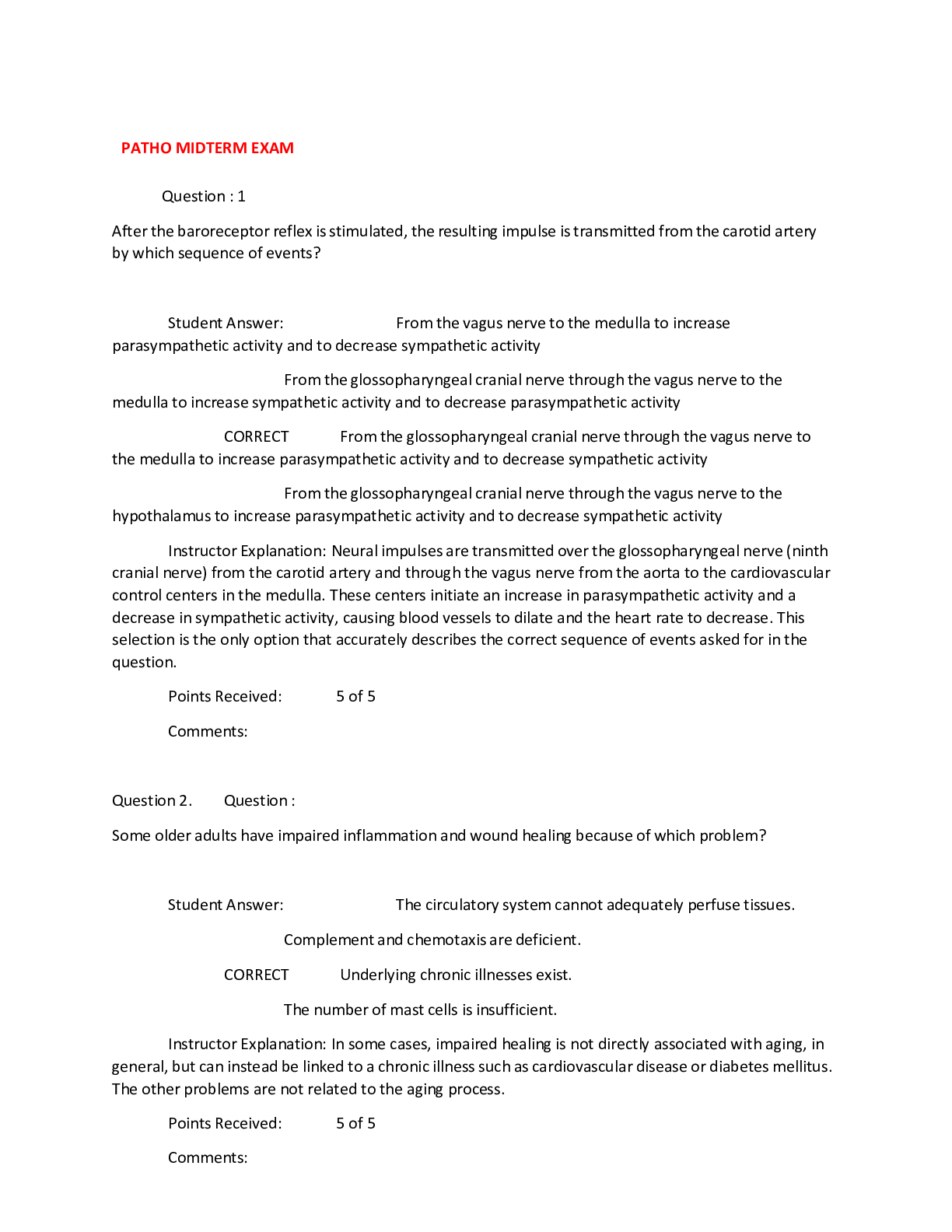
Buy this document to get the full access instantly
Instant Download Access after purchase
Buy NowInstant download
We Accept:

Reviews( 0 )
$18.00
Can't find what you want? Try our AI powered Search
Document information
Connected school, study & course
About the document
Uploaded On
Apr 14, 2021
Number of pages
19
Written in
All
Additional information
This document has been written for:
Uploaded
Apr 14, 2021
Downloads
0
Views
146

 HESI VI EXIT EXAM.png)
